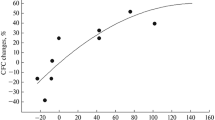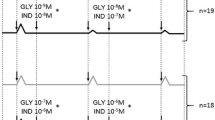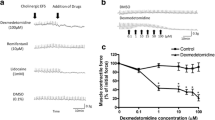Summary
The effects of atropine, pancuronium and gallamine were tested on pre- and post-junctional muscarinic receptors in the lung. Inhibition of bronchoconstriction induced by intravenous injection of acetylcholine (ACh) was used as a measure of post-junctional receptor blockade. All three antagonists reduced ACh-induced bronchoconstriction. The effects were dose-related for atropine and pancuronium and complete inhibition was obtained with 0.01 mg/kg and 10 mg/kg respectively. Gallamine was much less potent than the other two drugs; the inhibitory effect was not dose-related and never exceeded 50% even at a dose of 10 mg/kg. In contrast, blockade of pre-junctional inhibitory muscarinic receptors in pulmonary parasympathetic nerves by these three antagonists, produced potentiation of bronchoconstriction induced by vagal-nerve stimulation. Consequently, the effect of the three antagonists on vagally-induced bronchoconstriction is dependent on the balance between their pre- and post-junctional blocking activity. Gallamine was the most effective and atropine the least effective antagonist for potentiating nerve-induced bronchoconstriction. At doses which produce 100% neuromuscular blockade, both pancuronium (0.04 mg/kg) and gallamine (4 mg/kg) potentiated vagally-induced bronchoconstriction. At these doses, pancuronium doubled and gallamine caused a four-fold increase in vagally-induced bronchoconstriction, despite partial concurrent blockade of muscarinic receptors in the smooth muscle of the airways.
Similar content being viewed by others
References
Ashe JH, Yarosh CA (1984) Differential and selective antagonism of the slow-inhibitory postsynaptic potential and slow-excitatory postsynaptic potential by gallamine and pirenzipine in the superior cervical ganglion of the rabbit. Neuropharmacology 23:1321–1329
Barlow RB, Franks FM, Pearson JDM (1972) A comparison of the affinities of antagonists for acetylcholine receptors in the ileum, bronchial muscle and iris of the guinea-pig. Br J Pharmacol 46:300–314
Barlow RB, Weston-Smith P (1985) The relative potencies of some agonists at M2 muscarinic receptors in guinea-pig ileum, atria, and bronchi. Br J Pharmacol 85:437–440
Blaber LC, Fryer AD, Maclagan J (1985) Neuronal muscarinic receptors attenuate vagally-induced contraction of feline bronchial smooth muscle. Br J Pharmacol 86:723–728
Birdsall NJM, Hulme EC (1984) Muscarinic receptor subclasses. T.I.P.S. 4:459–463
Clague RU, Eglen RM, Strachan AC, Whiting RL (1985) Action of agonists and antagonists at muscarinic receptors present on ileum and atria in vitro. Br J Pharmacol 86:163–170
Clark AL, Mitchelson F (1976) The inhibitory effect of gallamine on muscarinic receptors. Br J Pharmacol 58:323–331
Dalton DW, Tyers MB (1982) A comparison of the muscarinic antagonist actions of pancuronium and alcuronium. J Auton Pharmacol 2:261–266
Dixon WE, Brodie TG (1903) Contributions to the physiology of the lungs. Part 1. The bronchial muscles and their innervation and the action of drugs upon them. J Physiol 29:97–173
Docherty JR, McGrath JC (1978) Sympathomimetic effects of pancuronium bromide and its monoquaternary analogue ORG NC45, on autonomic and somatic neurotransmission in the rat. Br J Pharmacol 71:225–228
Fryer AD, Maclagan J (1984) Muscarinic inhibitory receptors in pulmonary parasympathetic nerves in the guinea-pig. Br J Pharmacol 83:973–978
Gardier RW, Ganansia M, Delaunois AL, Hamelberg W (1974) Enhancemcent of ganglionic muscarinic activity by gallamine. Anesthesiology 40:494–497
Halonen M, Bloom JW, Yamamura H (1986) Characterisation of muscarinic receptor subtypes involved in vagally-induced bronchoconstriction. T.I.P.S. (Suppl) Subtypes of muscarinic receptors II, pp 90–91
Hughes R, Chapple DJ (1976) Effects of non-depolarizing neuromuscular blocking agents on peripheral autonomic mechanisms in cats. Br J Anaesth 48:59–67
Libet B, Tosaka T (1970) Dopamine as a synaptic transmitter and modulator in sympathetic ganglia. A different mode of synaptic action. Proceedings of the National Academy of Sciences, Washington, 67:667–673
Maclagan J, Ney UM (1979) Investigation of the mechanism of propranolol-induced bronchoconstriction. Br J Pharmacol 66:409–418
Marshall RJ, McGrath JC, Miller RD, Docherty JR, Lamar JC (1980) Comparison of the cardiovascular actions of Org. NC45 with those produced by other non-depolarizing neuromuscular blocking agents in experimental animals. Br J Anaesth 52:215–315
Mitchelson F (1984) Heterogeneity in muscarinic receptors: evidence from pharmacologic studies with antagonists. T.I.P.S. (Suppl I) pp 12–16
Riker WF, Wescoe WC (1951) The pharmacology of flaxedil with observations on certain analogues. Ann New York Acad Sci 54:373–392
Vercruysse P, Bosseyt P, Hanegreefs G, Verbeuten TJ, Vanhoutte PM (1979) Gallamine and pancuronium inhibit pre-junctional and post-junctional muscarinic receptors in canine saphenous vein. J Pharm Exp Ther 209:225–230
Wetzel GT, Brown JH (1985) Presynaptic modulation of acetylcholine release from cardiac parasympathetic neurons. Am J Physiol 248:H33-H39
Author information
Authors and Affiliations
Additional information
Send offprint requests to J. Maclagan at the above address
Rights and permissions
About this article
Cite this article
Fryer, A.D., Maclagan, J. Pancuronium and gallamine are antagonists for pre- and post-junctional muscarinic receptors in the guinea-pig lung. Naunyn-Schmiedeberg's Arch Pharmacol 335, 367–371 (1987). https://doi.org/10.1007/BF00165549
Received:
Accepted:
Issue Date:
DOI: https://doi.org/10.1007/BF00165549




